Sustainable Home Design Principles
VerifiedAdded on 2020/03/23
|9
|1517
|121
AI Summary
The assignment delves into the crucial aspects of sustainable home design. It emphasizes the importance of energy-efficient construction techniques, incorporating renewable energy sources, minimizing waste generation through recycling and reuse, and promoting environmentally friendly practices to reduce carbon emissions and preserve resources.
Contribute Materials
Your contribution can guide someone’s learning journey. Share your
documents today.
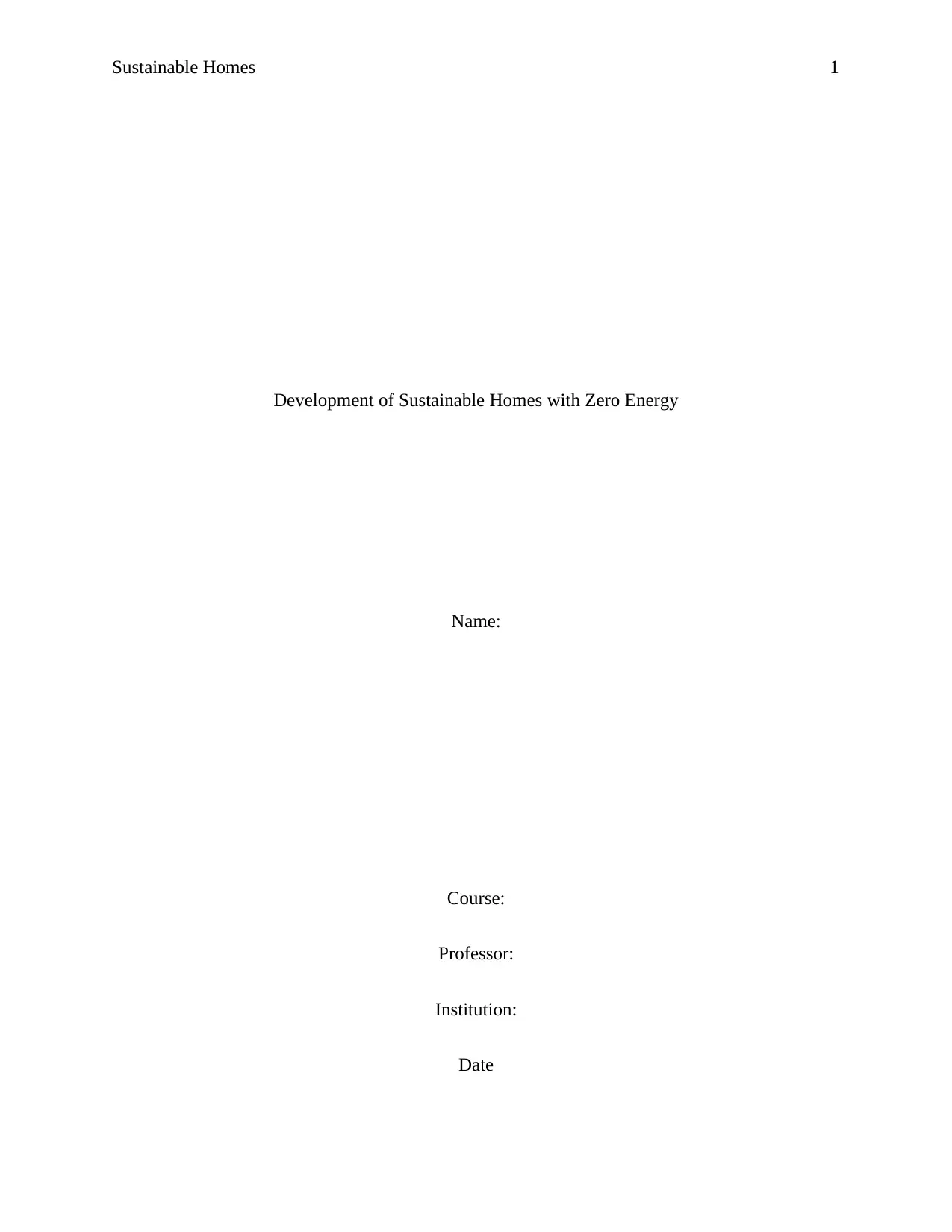
Sustainable Homes 1
Development of Sustainable Homes with Zero Energy
Name:
Course:
Professor:
Institution:
Date
Development of Sustainable Homes with Zero Energy
Name:
Course:
Professor:
Institution:
Date
Secure Best Marks with AI Grader
Need help grading? Try our AI Grader for instant feedback on your assignments.
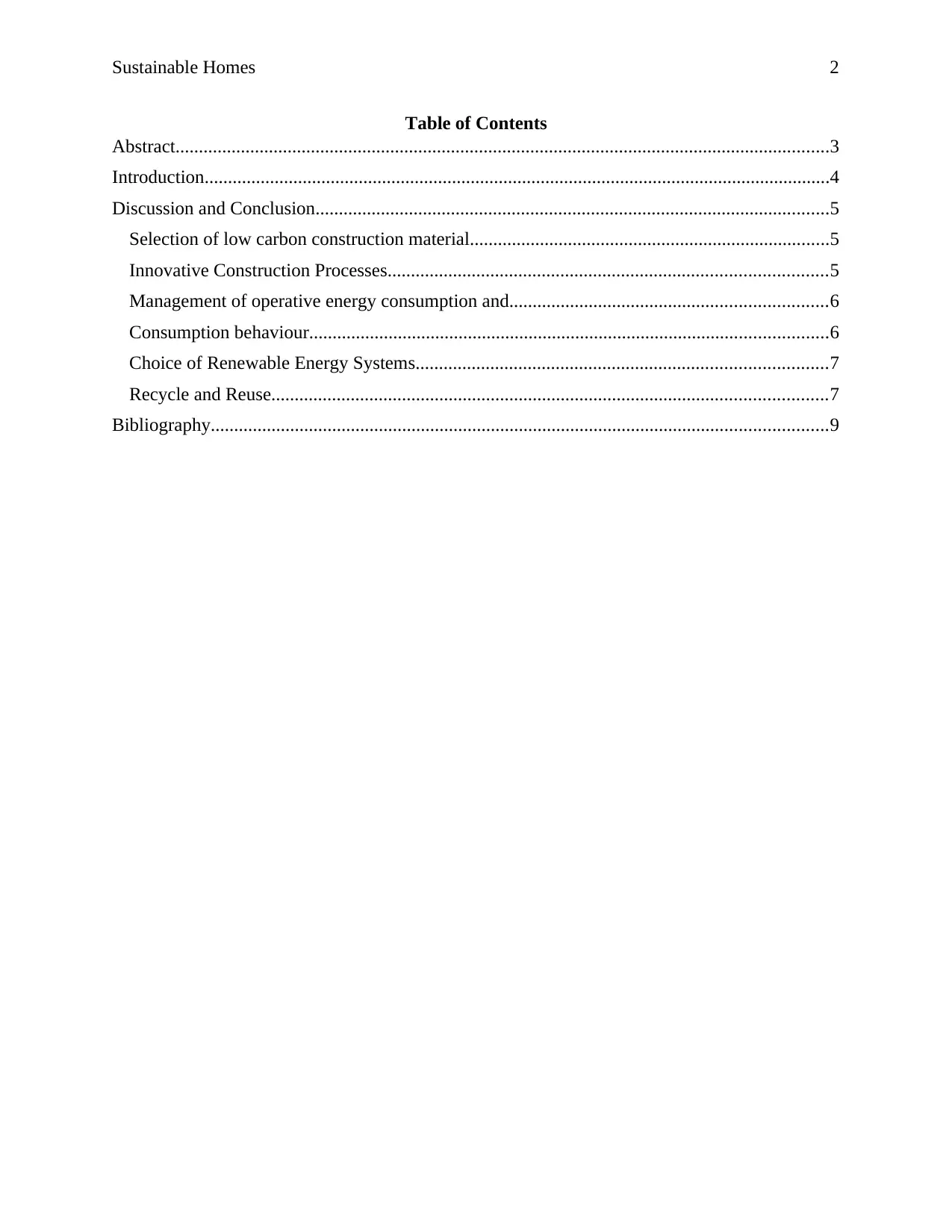
Sustainable Homes 2
Table of Contents
Abstract............................................................................................................................................3
Introduction......................................................................................................................................4
Discussion and Conclusion..............................................................................................................5
Selection of low carbon construction material.............................................................................5
Innovative Construction Processes..............................................................................................5
Management of operative energy consumption and....................................................................6
Consumption behaviour...............................................................................................................6
Choice of Renewable Energy Systems........................................................................................7
Recycle and Reuse.......................................................................................................................7
Bibliography....................................................................................................................................9
Table of Contents
Abstract............................................................................................................................................3
Introduction......................................................................................................................................4
Discussion and Conclusion..............................................................................................................5
Selection of low carbon construction material.............................................................................5
Innovative Construction Processes..............................................................................................5
Management of operative energy consumption and....................................................................6
Consumption behaviour...............................................................................................................6
Choice of Renewable Energy Systems........................................................................................7
Recycle and Reuse.......................................................................................................................7
Bibliography....................................................................................................................................9
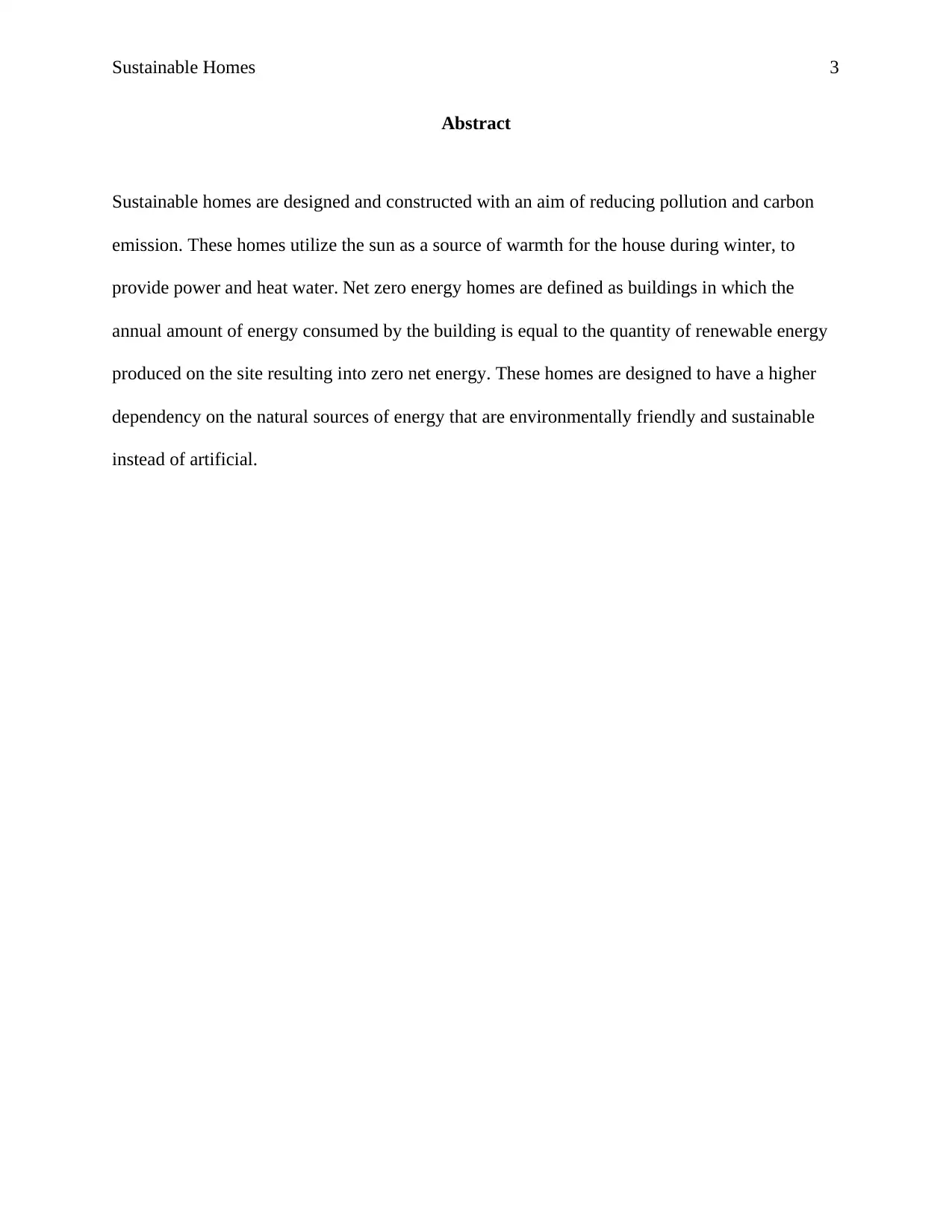
Sustainable Homes 3
Abstract
Sustainable homes are designed and constructed with an aim of reducing pollution and carbon
emission. These homes utilize the sun as a source of warmth for the house during winter, to
provide power and heat water. Net zero energy homes are defined as buildings in which the
annual amount of energy consumed by the building is equal to the quantity of renewable energy
produced on the site resulting into zero net energy. These homes are designed to have a higher
dependency on the natural sources of energy that are environmentally friendly and sustainable
instead of artificial.
Abstract
Sustainable homes are designed and constructed with an aim of reducing pollution and carbon
emission. These homes utilize the sun as a source of warmth for the house during winter, to
provide power and heat water. Net zero energy homes are defined as buildings in which the
annual amount of energy consumed by the building is equal to the quantity of renewable energy
produced on the site resulting into zero net energy. These homes are designed to have a higher
dependency on the natural sources of energy that are environmentally friendly and sustainable
instead of artificial.
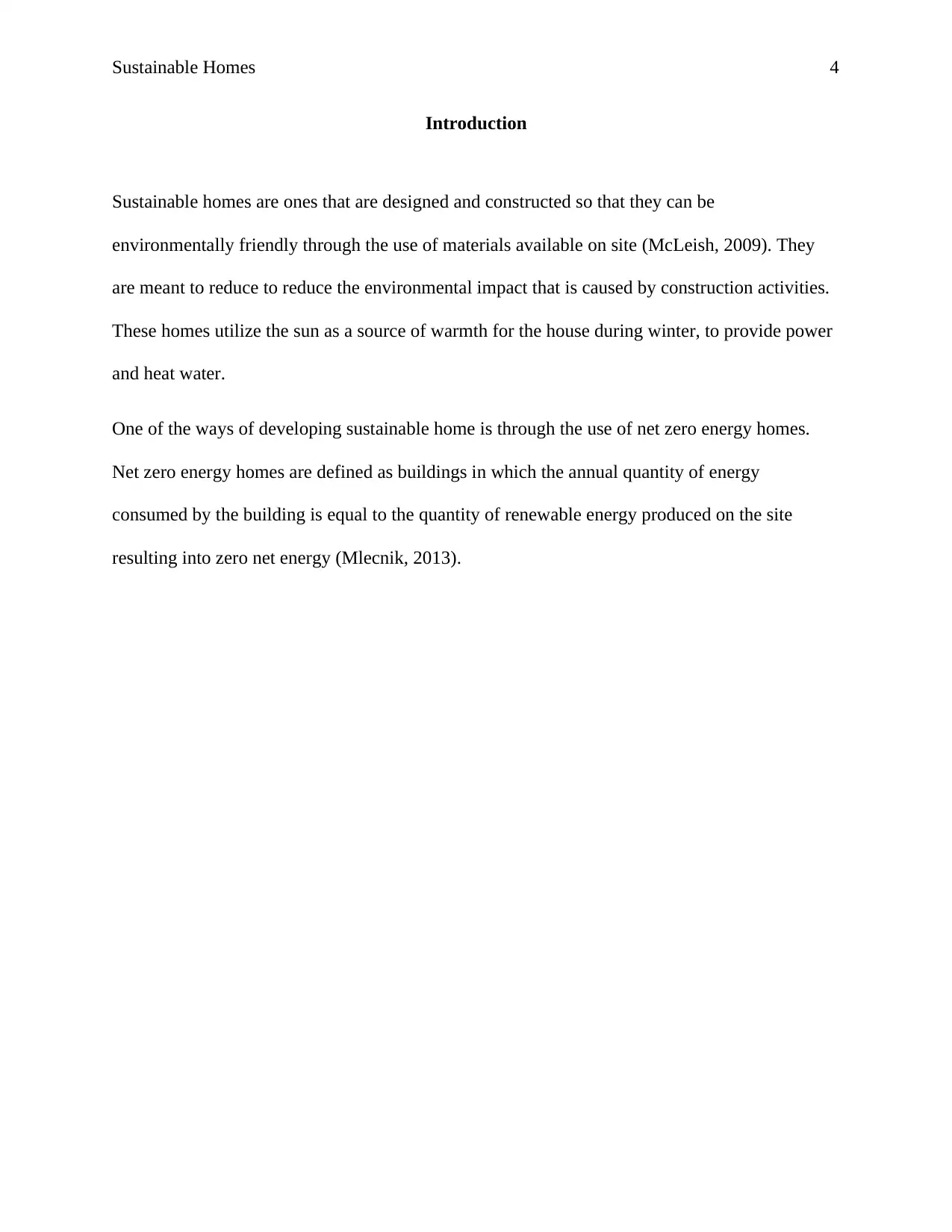
Sustainable Homes 4
Introduction
Sustainable homes are ones that are designed and constructed so that they can be
environmentally friendly through the use of materials available on site (McLeish, 2009). They
are meant to reduce to reduce the environmental impact that is caused by construction activities.
These homes utilize the sun as a source of warmth for the house during winter, to provide power
and heat water.
One of the ways of developing sustainable home is through the use of net zero energy homes.
Net zero energy homes are defined as buildings in which the annual quantity of energy
consumed by the building is equal to the quantity of renewable energy produced on the site
resulting into zero net energy (Mlecnik, 2013).
Introduction
Sustainable homes are ones that are designed and constructed so that they can be
environmentally friendly through the use of materials available on site (McLeish, 2009). They
are meant to reduce to reduce the environmental impact that is caused by construction activities.
These homes utilize the sun as a source of warmth for the house during winter, to provide power
and heat water.
One of the ways of developing sustainable home is through the use of net zero energy homes.
Net zero energy homes are defined as buildings in which the annual quantity of energy
consumed by the building is equal to the quantity of renewable energy produced on the site
resulting into zero net energy (Mlecnik, 2013).
Secure Best Marks with AI Grader
Need help grading? Try our AI Grader for instant feedback on your assignments.
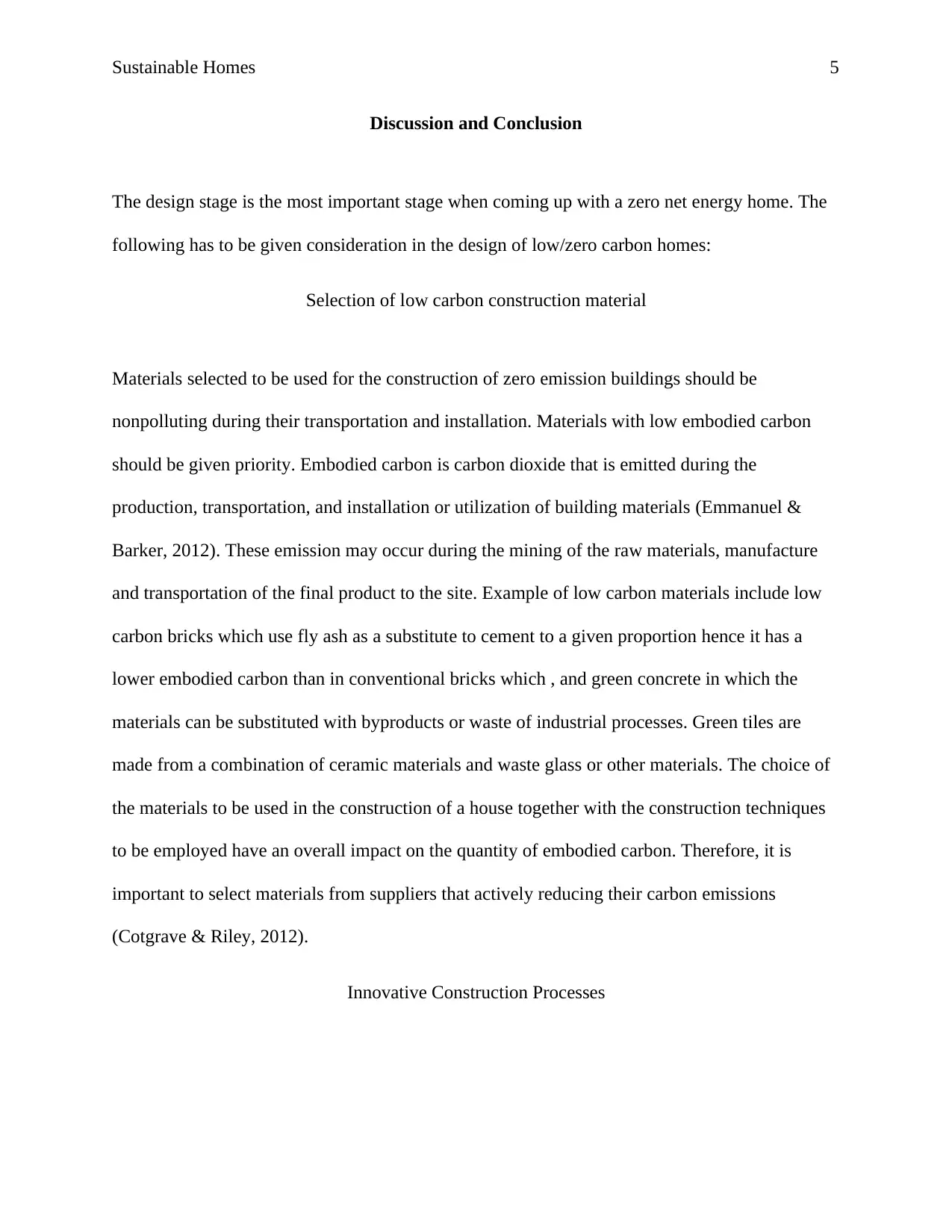
Sustainable Homes 5
Discussion and Conclusion
The design stage is the most important stage when coming up with a zero net energy home. The
following has to be given consideration in the design of low/zero carbon homes:
Selection of low carbon construction material
Materials selected to be used for the construction of zero emission buildings should be
nonpolluting during their transportation and installation. Materials with low embodied carbon
should be given priority. Embodied carbon is carbon dioxide that is emitted during the
production, transportation, and installation or utilization of building materials (Emmanuel &
Barker, 2012). These emission may occur during the mining of the raw materials, manufacture
and transportation of the final product to the site. Example of low carbon materials include low
carbon bricks which use fly ash as a substitute to cement to a given proportion hence it has a
lower embodied carbon than in conventional bricks which , and green concrete in which the
materials can be substituted with byproducts or waste of industrial processes. Green tiles are
made from a combination of ceramic materials and waste glass or other materials. The choice of
the materials to be used in the construction of a house together with the construction techniques
to be employed have an overall impact on the quantity of embodied carbon. Therefore, it is
important to select materials from suppliers that actively reducing their carbon emissions
(Cotgrave & Riley, 2012).
Innovative Construction Processes
Discussion and Conclusion
The design stage is the most important stage when coming up with a zero net energy home. The
following has to be given consideration in the design of low/zero carbon homes:
Selection of low carbon construction material
Materials selected to be used for the construction of zero emission buildings should be
nonpolluting during their transportation and installation. Materials with low embodied carbon
should be given priority. Embodied carbon is carbon dioxide that is emitted during the
production, transportation, and installation or utilization of building materials (Emmanuel &
Barker, 2012). These emission may occur during the mining of the raw materials, manufacture
and transportation of the final product to the site. Example of low carbon materials include low
carbon bricks which use fly ash as a substitute to cement to a given proportion hence it has a
lower embodied carbon than in conventional bricks which , and green concrete in which the
materials can be substituted with byproducts or waste of industrial processes. Green tiles are
made from a combination of ceramic materials and waste glass or other materials. The choice of
the materials to be used in the construction of a house together with the construction techniques
to be employed have an overall impact on the quantity of embodied carbon. Therefore, it is
important to select materials from suppliers that actively reducing their carbon emissions
(Cotgrave & Riley, 2012).
Innovative Construction Processes
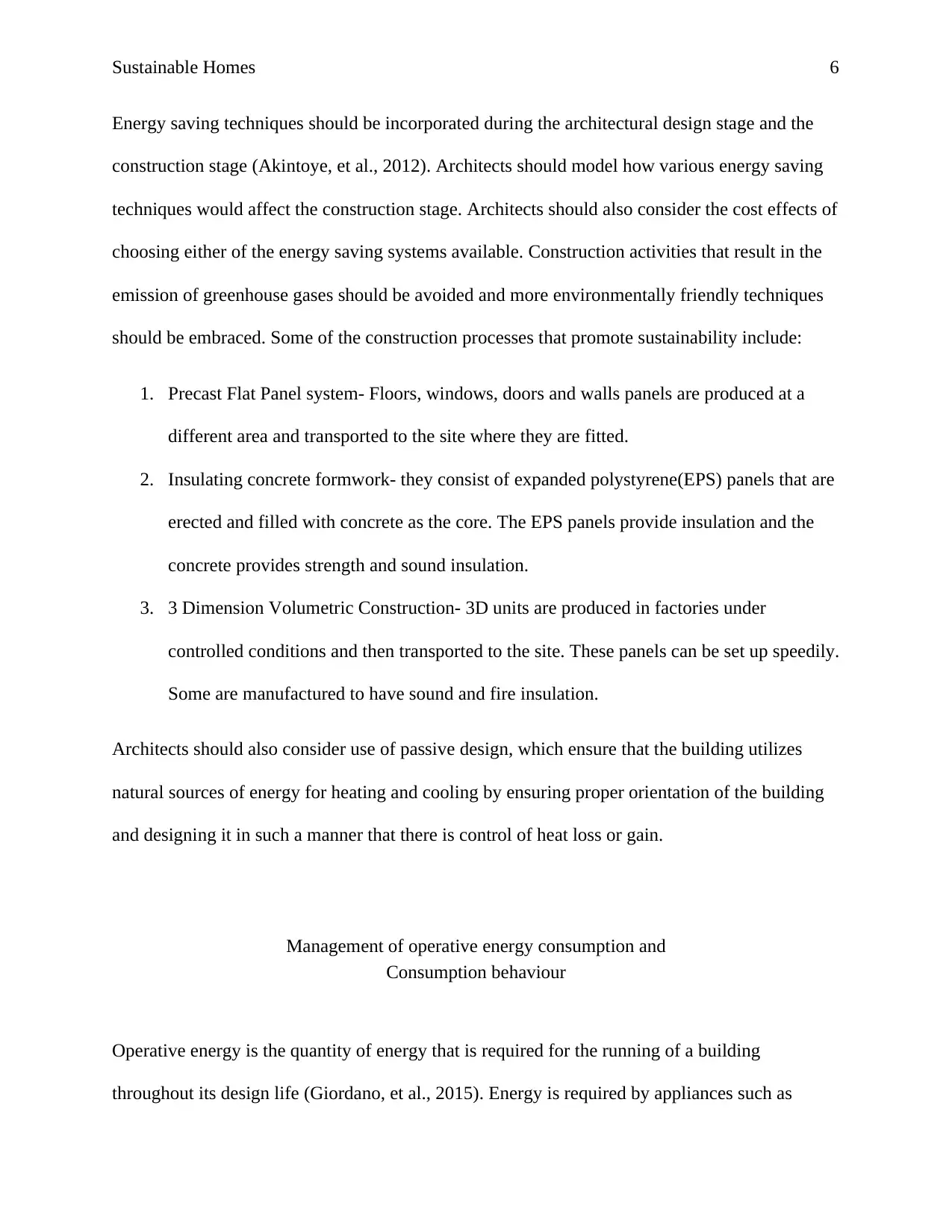
Sustainable Homes 6
Energy saving techniques should be incorporated during the architectural design stage and the
construction stage (Akintoye, et al., 2012). Architects should model how various energy saving
techniques would affect the construction stage. Architects should also consider the cost effects of
choosing either of the energy saving systems available. Construction activities that result in the
emission of greenhouse gases should be avoided and more environmentally friendly techniques
should be embraced. Some of the construction processes that promote sustainability include:
1. Precast Flat Panel system- Floors, windows, doors and walls panels are produced at a
different area and transported to the site where they are fitted.
2. Insulating concrete formwork- they consist of expanded polystyrene(EPS) panels that are
erected and filled with concrete as the core. The EPS panels provide insulation and the
concrete provides strength and sound insulation.
3. 3 Dimension Volumetric Construction- 3D units are produced in factories under
controlled conditions and then transported to the site. These panels can be set up speedily.
Some are manufactured to have sound and fire insulation.
Architects should also consider use of passive design, which ensure that the building utilizes
natural sources of energy for heating and cooling by ensuring proper orientation of the building
and designing it in such a manner that there is control of heat loss or gain.
Management of operative energy consumption and
Consumption behaviour
Operative energy is the quantity of energy that is required for the running of a building
throughout its design life (Giordano, et al., 2015). Energy is required by appliances such as
Energy saving techniques should be incorporated during the architectural design stage and the
construction stage (Akintoye, et al., 2012). Architects should model how various energy saving
techniques would affect the construction stage. Architects should also consider the cost effects of
choosing either of the energy saving systems available. Construction activities that result in the
emission of greenhouse gases should be avoided and more environmentally friendly techniques
should be embraced. Some of the construction processes that promote sustainability include:
1. Precast Flat Panel system- Floors, windows, doors and walls panels are produced at a
different area and transported to the site where they are fitted.
2. Insulating concrete formwork- they consist of expanded polystyrene(EPS) panels that are
erected and filled with concrete as the core. The EPS panels provide insulation and the
concrete provides strength and sound insulation.
3. 3 Dimension Volumetric Construction- 3D units are produced in factories under
controlled conditions and then transported to the site. These panels can be set up speedily.
Some are manufactured to have sound and fire insulation.
Architects should also consider use of passive design, which ensure that the building utilizes
natural sources of energy for heating and cooling by ensuring proper orientation of the building
and designing it in such a manner that there is control of heat loss or gain.
Management of operative energy consumption and
Consumption behaviour
Operative energy is the quantity of energy that is required for the running of a building
throughout its design life (Giordano, et al., 2015). Energy is required by appliances such as
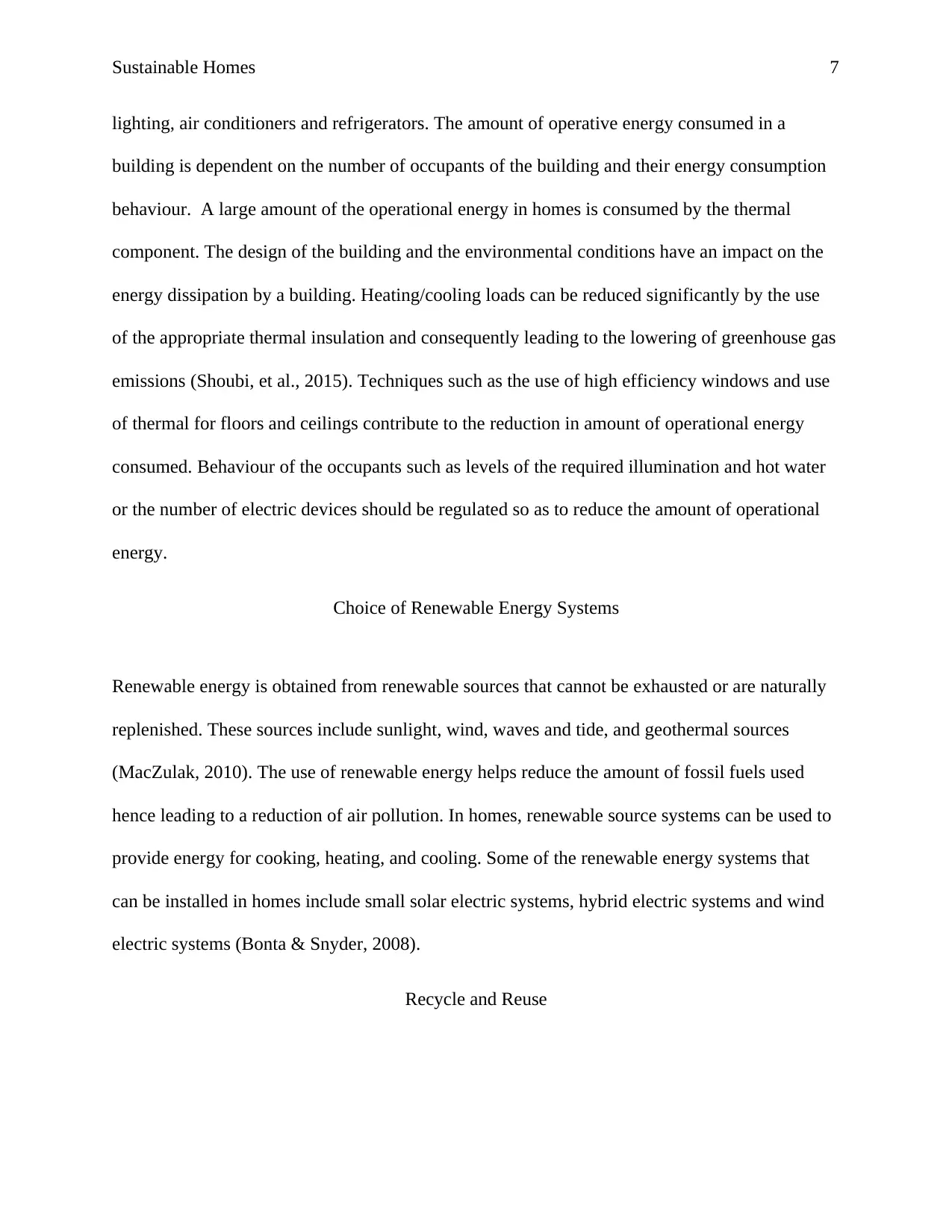
Sustainable Homes 7
lighting, air conditioners and refrigerators. The amount of operative energy consumed in a
building is dependent on the number of occupants of the building and their energy consumption
behaviour. A large amount of the operational energy in homes is consumed by the thermal
component. The design of the building and the environmental conditions have an impact on the
energy dissipation by a building. Heating/cooling loads can be reduced significantly by the use
of the appropriate thermal insulation and consequently leading to the lowering of greenhouse gas
emissions (Shoubi, et al., 2015). Techniques such as the use of high efficiency windows and use
of thermal for floors and ceilings contribute to the reduction in amount of operational energy
consumed. Behaviour of the occupants such as levels of the required illumination and hot water
or the number of electric devices should be regulated so as to reduce the amount of operational
energy.
Choice of Renewable Energy Systems
Renewable energy is obtained from renewable sources that cannot be exhausted or are naturally
replenished. These sources include sunlight, wind, waves and tide, and geothermal sources
(MacZulak, 2010). The use of renewable energy helps reduce the amount of fossil fuels used
hence leading to a reduction of air pollution. In homes, renewable source systems can be used to
provide energy for cooking, heating, and cooling. Some of the renewable energy systems that
can be installed in homes include small solar electric systems, hybrid electric systems and wind
electric systems (Bonta & Snyder, 2008).
Recycle and Reuse
lighting, air conditioners and refrigerators. The amount of operative energy consumed in a
building is dependent on the number of occupants of the building and their energy consumption
behaviour. A large amount of the operational energy in homes is consumed by the thermal
component. The design of the building and the environmental conditions have an impact on the
energy dissipation by a building. Heating/cooling loads can be reduced significantly by the use
of the appropriate thermal insulation and consequently leading to the lowering of greenhouse gas
emissions (Shoubi, et al., 2015). Techniques such as the use of high efficiency windows and use
of thermal for floors and ceilings contribute to the reduction in amount of operational energy
consumed. Behaviour of the occupants such as levels of the required illumination and hot water
or the number of electric devices should be regulated so as to reduce the amount of operational
energy.
Choice of Renewable Energy Systems
Renewable energy is obtained from renewable sources that cannot be exhausted or are naturally
replenished. These sources include sunlight, wind, waves and tide, and geothermal sources
(MacZulak, 2010). The use of renewable energy helps reduce the amount of fossil fuels used
hence leading to a reduction of air pollution. In homes, renewable source systems can be used to
provide energy for cooking, heating, and cooling. Some of the renewable energy systems that
can be installed in homes include small solar electric systems, hybrid electric systems and wind
electric systems (Bonta & Snyder, 2008).
Recycle and Reuse
Paraphrase This Document
Need a fresh take? Get an instant paraphrase of this document with our AI Paraphraser
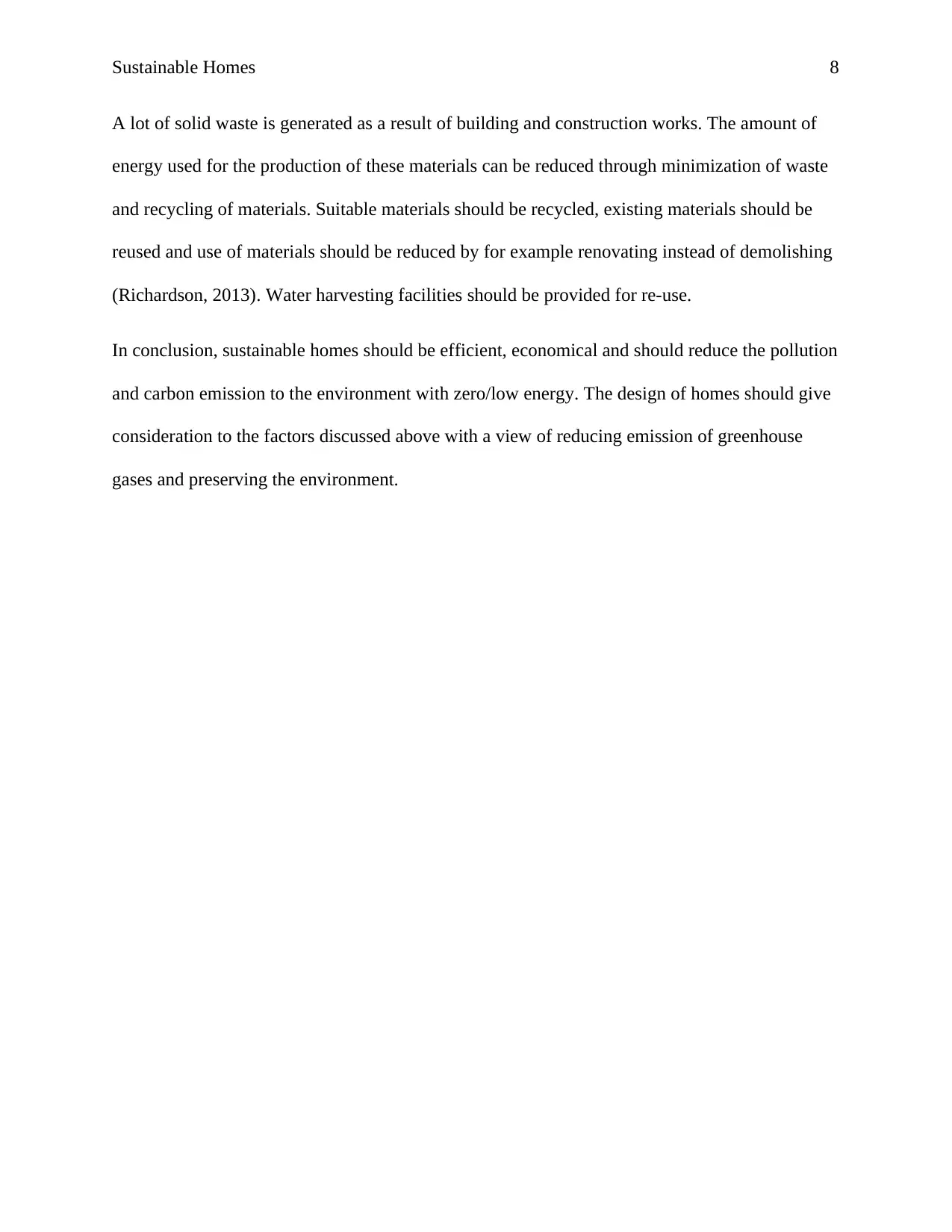
Sustainable Homes 8
A lot of solid waste is generated as a result of building and construction works. The amount of
energy used for the production of these materials can be reduced through minimization of waste
and recycling of materials. Suitable materials should be recycled, existing materials should be
reused and use of materials should be reduced by for example renovating instead of demolishing
(Richardson, 2013). Water harvesting facilities should be provided for re-use.
In conclusion, sustainable homes should be efficient, economical and should reduce the pollution
and carbon emission to the environment with zero/low energy. The design of homes should give
consideration to the factors discussed above with a view of reducing emission of greenhouse
gases and preserving the environment.
A lot of solid waste is generated as a result of building and construction works. The amount of
energy used for the production of these materials can be reduced through minimization of waste
and recycling of materials. Suitable materials should be recycled, existing materials should be
reused and use of materials should be reduced by for example renovating instead of demolishing
(Richardson, 2013). Water harvesting facilities should be provided for re-use.
In conclusion, sustainable homes should be efficient, economical and should reduce the pollution
and carbon emission to the environment with zero/low energy. The design of homes should give
consideration to the factors discussed above with a view of reducing emission of greenhouse
gases and preserving the environment.
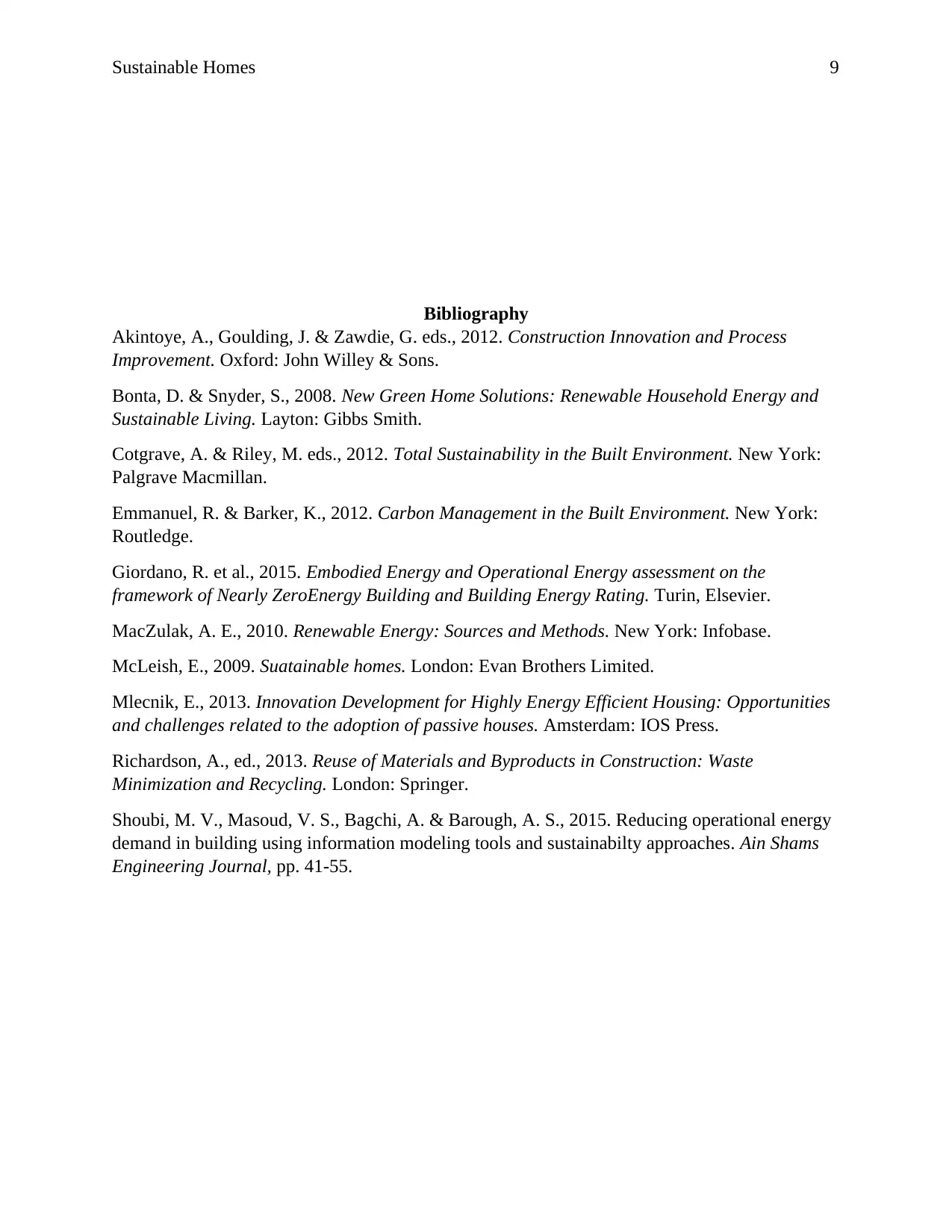
Sustainable Homes 9
Bibliography
Akintoye, A., Goulding, J. & Zawdie, G. eds., 2012. Construction Innovation and Process
Improvement. Oxford: John Willey & Sons.
Bonta, D. & Snyder, S., 2008. New Green Home Solutions: Renewable Household Energy and
Sustainable Living. Layton: Gibbs Smith.
Cotgrave, A. & Riley, M. eds., 2012. Total Sustainability in the Built Environment. New York:
Palgrave Macmillan.
Emmanuel, R. & Barker, K., 2012. Carbon Management in the Built Environment. New York:
Routledge.
Giordano, R. et al., 2015. Embodied Energy and Operational Energy assessment on the
framework of Nearly ZeroEnergy Building and Building Energy Rating. Turin, Elsevier.
MacZulak, A. E., 2010. Renewable Energy: Sources and Methods. New York: Infobase.
McLeish, E., 2009. Suatainable homes. London: Evan Brothers Limited.
Mlecnik, E., 2013. Innovation Development for Highly Energy Efficient Housing: Opportunities
and challenges related to the adoption of passive houses. Amsterdam: IOS Press.
Richardson, A., ed., 2013. Reuse of Materials and Byproducts in Construction: Waste
Minimization and Recycling. London: Springer.
Shoubi, M. V., Masoud, V. S., Bagchi, A. & Barough, A. S., 2015. Reducing operational energy
demand in building using information modeling tools and sustainabilty approaches. Ain Shams
Engineering Journal, pp. 41-55.
Bibliography
Akintoye, A., Goulding, J. & Zawdie, G. eds., 2012. Construction Innovation and Process
Improvement. Oxford: John Willey & Sons.
Bonta, D. & Snyder, S., 2008. New Green Home Solutions: Renewable Household Energy and
Sustainable Living. Layton: Gibbs Smith.
Cotgrave, A. & Riley, M. eds., 2012. Total Sustainability in the Built Environment. New York:
Palgrave Macmillan.
Emmanuel, R. & Barker, K., 2012. Carbon Management in the Built Environment. New York:
Routledge.
Giordano, R. et al., 2015. Embodied Energy and Operational Energy assessment on the
framework of Nearly ZeroEnergy Building and Building Energy Rating. Turin, Elsevier.
MacZulak, A. E., 2010. Renewable Energy: Sources and Methods. New York: Infobase.
McLeish, E., 2009. Suatainable homes. London: Evan Brothers Limited.
Mlecnik, E., 2013. Innovation Development for Highly Energy Efficient Housing: Opportunities
and challenges related to the adoption of passive houses. Amsterdam: IOS Press.
Richardson, A., ed., 2013. Reuse of Materials and Byproducts in Construction: Waste
Minimization and Recycling. London: Springer.
Shoubi, M. V., Masoud, V. S., Bagchi, A. & Barough, A. S., 2015. Reducing operational energy
demand in building using information modeling tools and sustainabilty approaches. Ain Shams
Engineering Journal, pp. 41-55.
1 out of 9
Related Documents
Your All-in-One AI-Powered Toolkit for Academic Success.
+13062052269
info@desklib.com
Available 24*7 on WhatsApp / Email
![[object Object]](/_next/static/media/star-bottom.7253800d.svg)
Unlock your academic potential
© 2024 | Zucol Services PVT LTD | All rights reserved.





